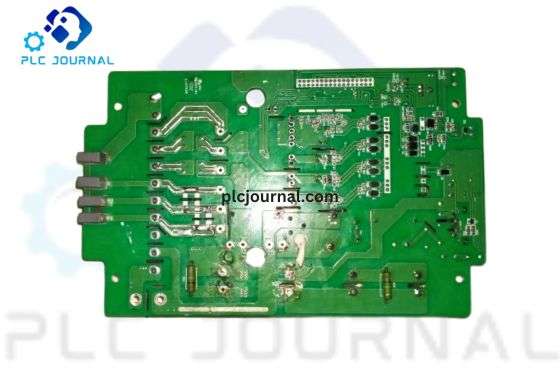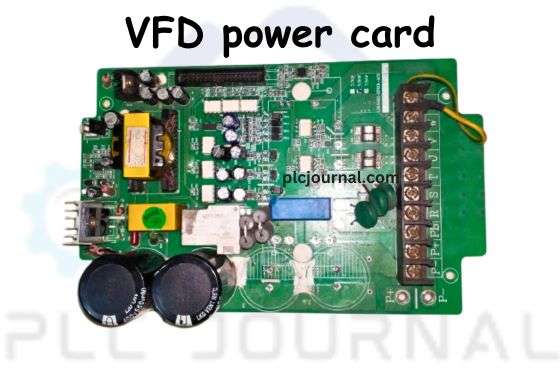Introduction
In the realm of Variable Frequency Drives (VFDs), the power card stands as a cornerstone. Effectively orchestrating the intricate dance of electrical energy conversion within these vital devices. Furthermore, this article delves deep into the anatomy and significance of the VFD power card. Thereby elucidating its pivotal role in regulating power flow and, consequently, motor performance.
Understanding the VFD Power Card

At the heart of a VFD, lies the power card, which is essentially a module comprising an amalgamation of sophisticated electronic components. All of which are meticulously engineered to effectively perform a series of critical functions.
Rectification Stage
The journey first commences with rectification. Here, the power card initially harnesses incoming alternating current. (AC) power from the mains supply and subsequently undertakes the monumental task of converting it into direct current (DC) power. Moreover, this rectification process, facilitated by diodes and other circuitry. Effectively ensures a stable and consistent flow of DC power within the VFD.
Inverter Functionality
Following rectification, the power card transitions to the inverter stage. A pivotal phase where DC power transformed back into variable-frequency AC power. This stage governs the frequency and voltage output, allowing precise control over the speed and torque of the connected motor.
Control and Safeguarding Mechanisms
Embedded within the power card are intricate control systems and protective measures. These mechanisms meticulously monitor and regulate the power flow, ensuring the VFD operates within safe operational parameters. From overvoltage and undervoltage protection to shielding against overcurrents and short circuits. The power card’s guardianship ensures the safety and longevity of both the drive and connected equipment.
Thermal Management
Advanced iterations of the power card often integrate thermal management features. Heat dissipation managed through the inclusion of heat sinks or dedicated cooling systems. These elements play a crucial role in maintaining optimal operating temperatures for the VFD’s components, enhancing overall efficiency and reliability.
Significance in VFD Performance
The significance of the power card cannot overstated. Its meticulous orchestration of power conversion, control, and protection mechanisms forms the backbone of VFD functionality. This pivotal component not only facilitates precise motor speed and torque regulation. But also contributes significantly to energy efficiency and equipment durability.
Evolution and Future Prospects
As technology evolves, so does the landscape of VFD power cards. Furthermore, ongoing advancements consistently continue to refine their efficiency, reliability, and integration capabilities. Thereby paving the way for enhanced performance and, as a result, greater adaptability across diverse industrial as well as commercial applications.
What is VFD power?
VFD power refers to the electrical power supplied and managed by a Variable Frequency Drive (VFD) in an industrial or commercial setting. A VFD a sophisticated device used to control the speed, torque, and efficiency of electric motors by varying the frequency and voltage of the power supplied to the motor.
The power supplied by a VFD typically derived from an AC (alternating current) mains source, which then converted within the VFD to meet the specific requirements of the connected motor. Here are some key aspects related to VFD power:
Variable Frequency and Voltage: VFDs offer the capability to adjust both the frequency and voltage of the power supplied to the motor. This allows for precise control over the motor’s speed and torque, enabling optimal performance tailored to the specific needs of the application.
Conversion Process: The VFD manages the power through a series of stages. Initially, incoming AC power is rectified into DC power. Then subsequently converted back to variable-frequency AC power using an inverter stage. This conversion process orchestrated by components within the VFD, such as the power card, to ensure smooth and efficient power delivery.
Control and Regulation: VFDs incorporate sophisticated control systems that are specifically designed to regulate and monitor the power supplied to the motor. In addition, these systems adjust the frequency and voltage dynamically based on the requirements of the application, thereby allowing for precise control over motor speed, torque, and consequently, acceleration.
Energy Efficiency: One of the most significant advantages of VFD power is its ability to improve energy efficiency. Specifically, by adjusting the speed of the motor precisely based on the actual load requirements, VFDs prevent motors from running at maximum speed constantly, and as a result, they reduce energy consumption while also lowering operating costs.
Protection Mechanisms: VFDs also include protective features to safeguard the motor and the drive itself. These protections can include measures against overvoltage, undervoltage, overcurrent, overheating, and other potential issues that could affect the motor’s performance or cause damage.
Overall, VFD power represents the controlled and optimized electrical energy delivered to the motor by a Variable Frequency Drive, offering flexibility, efficiency, and precise control over motor operations in various industrial and commercial applications.
What is the function of VFD control card?
The VFD control card, also known as the control module or control circuit. Serves as the intelligence hub within a Variable Frequency Drive (VFD). It performs a range of crucial functions that govern the operation and regulation of the VFD and the connected motor. Here are the primary functions of the VFD control card:
Parameter Adjustment and Control: The control card manages various parameters of the VFD, such as frequency, voltage, acceleration, and deceleration rates. It allows users to set and adjust these parameters according to the specific requirements of the motor and the application.
Speed Regulation: One of the fundamental functions of the control card is to regulate the speed of the motor. It receives input signals and commands, then adjusts. The output frequency and voltage to control the motor’s speed precisely as needed.
Torque Control: The control card governs the torque output of the motor by manipulating the frequency and voltage supplied. This ensures that the motor delivers the required amount of force or torque without consuming unnecessary power.
Start-Up and Shutdown Sequences: It manages the start-up and shutdown sequences of the motor, ensuring smooth and controlled transitions to prevent mechanical stress and damage to the equipment.
Monitoring and Feedback: The control card constantly monitors various parameters of the motor, such as current, voltage, temperature, and operating conditions. It receives feedback from sensors and other components, allowing it to make real-time adjustments for optimal performance and safety.
Diagnostic and Protective Functions: The control card includes diagnostic capabilities to identify faults or irregularities in the system. It also integrates protective features to safeguard the VFD and motor against overvoltage, undervoltage, overcurrent, short circuits, and other potential issues that could cause damage.
Communication Interface: In some advanced VFDs, the control card includes communication interfaces (such as Modbus, Profibus, or Ethernet) to enable connectivity with external systems for data exchange, remote monitoring, and control.
The control card serves as the brain of the VFD, orchestrating and regulating the entire operation of the drive. Its ability to manage parameters, control motor functions, ensure safety, and provide. Operational feedback is integral to the efficient and reliable performance of the VFD and the connected motor.
Is VFD used in AC or DC?
Variable Frequency Drives (VFDs) are primarily used with AC (alternating current) motors. While VFDs themselves work with AC power, they are designed to control the speed, torque, and direction of AC induction motors or synchronous motors.
VFDs function by converting incoming AC power from the mains supply into DC power through a rectification process. This DC power is then converted back into variable-frequency AC power using an inverter within the VFD. By adjusting the frequency and voltage of this AC power. VFDs can precisely control the speed and torque of AC motors.
However, it’s worth noting that there are also drives designed specifically for DC motors, known as DC drives or DC motor controllers. These drives regulate the speed and torque of DC motors by adjusting the voltage supplied to the motor armature.
In summary, while VFDs themselves operate with AC power, they are used to control AC motors, offering variable-speed functionality and precise control over AC motor operations in various industrial, commercial, and residential applications.
Conclusion
In conclusion, the VFD power card stands as a testament to precision engineering. Serving as the nerve center of Variable Frequency Drives. Its multifaceted role in power conversion, control, and protection underscores its indispensability, driving efficiency, and reliability in countless industrial processes.
Technical Guides
What Is a Programmable Logic Controller (PLC)? Full Explanation
What is HMI? Human-Machine Interface (HMI)-Full Explanation
What is a Variable Frequency Drive?-It’s complete guidelines
What Is a Servo drive and How Does it Work? It’s complete guidelines
Manual PDF
[PDF] Delta PLC DVP-ES2/EX2/SS2/SA2/SX2/SE&TP Operation Manual Free Download
Delta HMI-DOPSoft User Manual Free Download [PDF]
Cable Making
[DIY-Cable] PLC/HMI-Panasonic Connecting PC
[DIY-Cable] PLC/HMI-Keyence Connecting PC
[DIY-Cable] S7-200 Siemens Connecting PC
[DIY-Cable] Mitsubishi PLC Programming Cable SC-09 for FX-Series
[DIY-Cable] PLC Delta Programming Cable DVPACAB230
[DIY-Cable] PLC OMRON Programing Cable for CJ/CS/CQ-Series
[DIY-Cable] PLC “LS/LG” Programing Cable
[DIY-Cable] PLC “Fatek/Facon” Programing Cable
[DIY-Cable] PLC “Vigor” Programing Cable
[DIY-Cable] HMI “Fuji/Hakko” Programing Cable
[DIY-Cable] “HMI Omron NT-Series” Programing Cable
[DIY-Cable] HMI Keyence “VT3-W4 Series” Cable Connecting To PLC
[PDF] HMI-Weintek Connection PLC Guide






